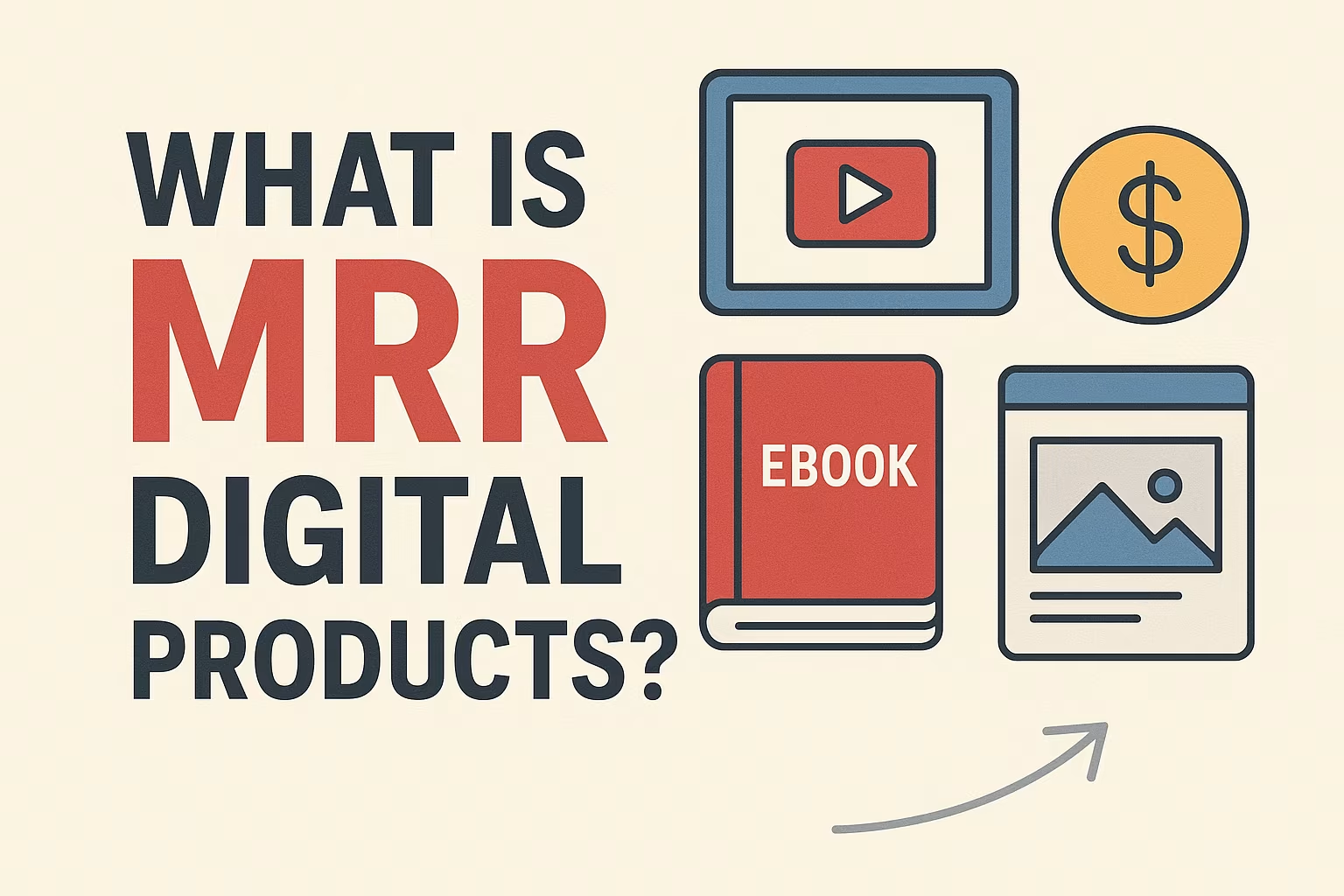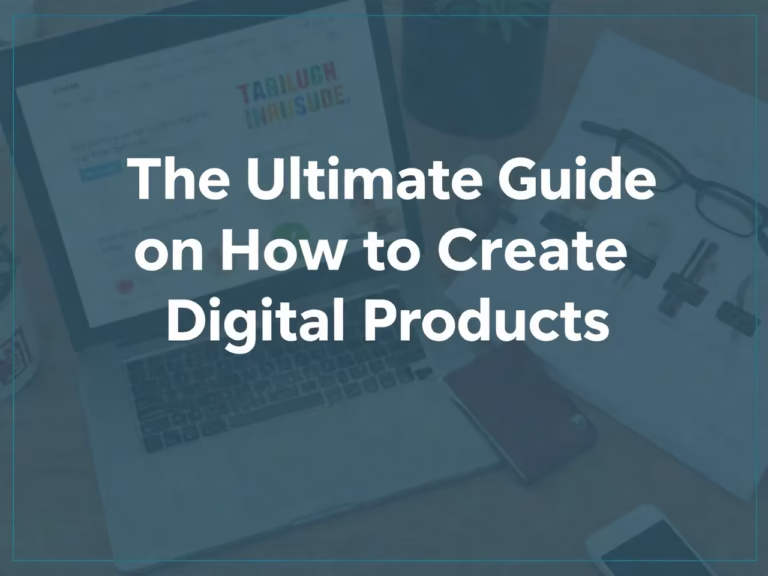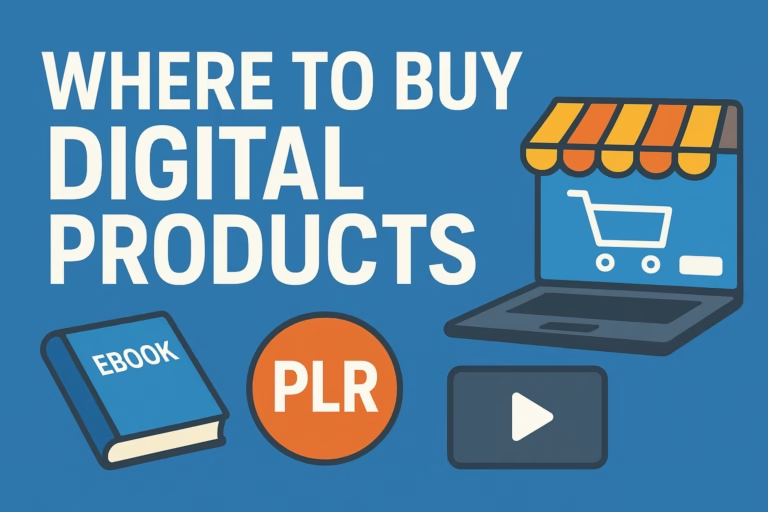What is MRR digital products?
In the digital age, entrepreneurs are constantly looking for new ways to create and sell products that can generate revenue with minimal ongoing effort. One powerful method is through selling MRR digital products (Master Resell Rights). But what exactly are MRR products, and why are they so appealing to those looking to enter the world of digital marketing?
MRR digital products are digital products that come with the right to resell them and, in most cases, offer you the ability to retain 100% of the profits. These products can range from eBooks, software, graphics, courses, templates, and more. For digital entrepreneurs, MRR products represent a business-in-a-box solution—an easy way to start selling without having to create a product from scratch.
Some popular digital products with master resell rights include templates, guides, videos, and software packages that have been pre-created by others and licensed for resale. As a seller, you simply purchase these products, get the resale rights, and market them to your audience, allowing you to earn profits on each sale.
Why choose MRR digital products? The beauty of MRR lies in its simplicity. You don’t have to invest your time creating a product, and you don’t need to deal with product development, inventory management, or shipping. All you need is a sales funnel and a method to market your products effectively. Whether you’re looking for a side hustle or a full-time business, MRR products can offer the perfect opportunity for earning online.
Master Resell Rights stands for MRR. An MRR digital product is a pre-made digital product (ebook, video course, templates, software, etc.) along with a license that allows the buyer not just to resell the product to end users, but typically to resell resale rights to such customers as well. That is, you buy the product once, sell it multiple times, and you may permit your customers to resell it too (subject to the terms of the particular license). Digital Products
MRR vs PLR vs Basic Resell Rights — the difference that really matters
Basic Resell Rights (RR): You can resell the product, but generally your customers cannot resell it again.
Master Resell Rights (MRR): You are allowed to resell the product and pass the resale right on to purchasers (i.e., transfer the rights).
Private Label Rights (PLR): You are allowed to rebrand, edit, and claim authorship in most PLR deals — more flexible but not usually the same as MRR. PLR allows editing and branding freedom; MRR usually requires you to sell the product mainly “as-is.”
This document aims to clarify the distinctions between Master Resell Rights (MRR), Private Label Rights (PLR), and Basic Resell Rights. Understanding these differences is crucial for anyone looking to purchase and utilize digital products for resale or content creation, ensuring you leverage the rights appropriately and avoid potential legal issues. We’ll break down each type of license, outlining what you can and cannot do with each, empowering you to make informed decisions about your digital assets.
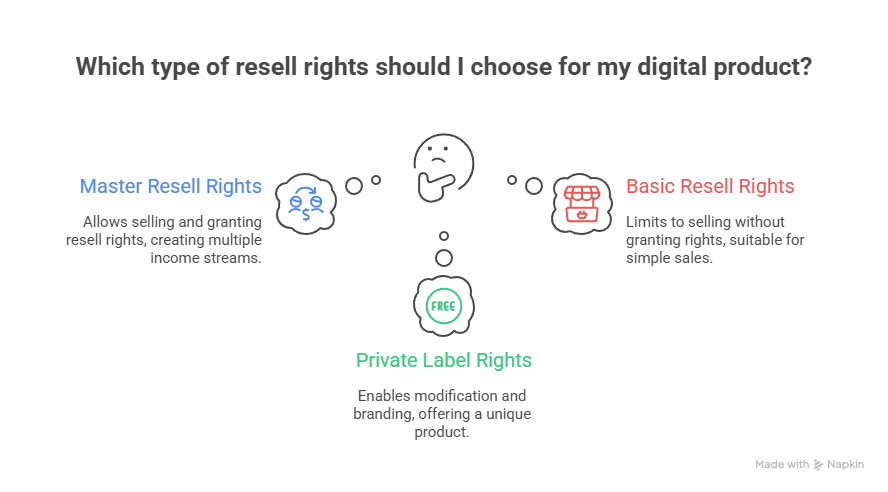
Resell Rights: The Foundation
At its core, a “Resell Right” grants you the permission to sell a product. However, the extent of these rights varies significantly, leading to the different categories we’ll explore.
Basic Resell Rights: The Simplest Form
What it is: Basic Resell Rights are the most restrictive form of resale rights. When you purchase a product with Basic Resell Rights, you are granted the right to sell that product to your customers.
What you can do:
- Sell the product: This is the primary right. You can offer the product for sale at a price you determine.
- Typically, offer personal use rights: Your customers usually get the right to use the product for their own purposes.
What you cannot do:
- Modify the product: You cannot alter the product in any way. This includes changing the content, design, or format.
- Claim authorship: You cannot claim that you created the product.
- Give away the product for free: You are generally restricted from giving the product away as a bonus or incentive.
- Transfer the resell rights: You cannot grant your customers the right to resell the product. They can only use it.
- Create derivative works: You cannot use the product as a basis for creating new products.
- Often, you cannot include the product in a membership site.
Example: Imagine you purchase an ebook with Basic Resell Rights. You can sell the ebook to your customers, and they can read it. However, you cannot change the ebook’s content, put your name on it, or allow your customers to resell it.
Master Resell Rights (MRR): A Step Up
What it is: Master Resell Rights offer more flexibility than Basic Resell Rights. With MRR, you not only have the right to sell the product itself, but you also gain the right to sell the resell rights to your customers.
What you can do:
- Sell the product: Just like with Basic Resell Rights, you can sell the product to your customers.
- Sell the resell rights: This is the key difference. You can grant your customers the right to resell the product themselves.
- Often, offer personal use rights: Your customers usually get the right to use the product for their own purposes.
What you cannot do (typically):
- Modify the product: You generally cannot alter the product’s content or design.
- Claim authorship: You cannot claim that you created the product.
- Give away the product for free: You are usually restricted from giving the product away as a bonus or incentive.
- Transfer Master Resell Rights: You usually cannot grant your customers the Master Resell Rights. They can only get basic resell rights.
- Create derivative works: You cannot use the product as a basis for creating new products.
- Often, you cannot include the product in a membership site.
Example: You purchase a software program with Master Resell Rights. You can sell the software to your customers, and you can also sell them the right to resell the software to their customers. However, you cannot change the software’s code or claim that you developed it. Your customers can only sell the software with basic resell rights.
Private Label Rights (PLR): The Most Flexible Option
What it is: Private Label Rights provide the most extensive rights. With PLR, you essentially purchase the product as if you were the original creator.
What you can do:
- Sell the product: You can sell the product to your customers.
- Modify the product: You can alter the product’s content, design, and format to suit your needs.
- Claim authorship: You can put your name on the product and present it as your own creation.
- Give away the product for free: You can use the product as a bonus, lead magnet, or incentive.
- Sell the resell rights: You can grant your customers the right to resell the product.
- Create derivative works: You can use the product as a basis for creating new products, such as ebooks, courses, or articles.
- Include the product in a membership site.
What you cannot do (typically – always check the license):
- Claim original authorship: While you can claim authorship after modifying the product, you cannot claim to be the original creator.
- Transfer PLR rights: You usually cannot grant your customers the Private Label Rights. They can only get basic resell rights, or sometimes MRR.
- Use the original author’s name: You cannot use the original author’s name in a way that suggests they endorse your modified product.
Example: You purchase a set of articles with Private Label Rights. You can rewrite the articles, add your own branding, and publish them on your blog under your name. You can also compile the articles into an ebook and sell it as your own product. You can also give the articles away as a free report to build your email list.
MRR vs PLR: Which Digital Product License is Right for Your Business?
If you’ve ever felt overwhelmed trying to understand the difference between MRR and PLR, you’re not alone. Many digital entrepreneurs struggle with this exact question before launching their online product business. The truth is, choosing the right license type can make or break your success in the digital marketplace.
I remember when I first started out, I purchased what I thought was a customizable product only to discover I couldn’t change a single word. It was frustrating, cost me both time and money, and taught me a valuable lesson about understanding digital product licenses before buying.
In this article, we’ll cut through the confusion and give you a crystal-clear understanding of both MRR and PLR, their differences, and—most importantly—how to choose the right option for your specific business needs.
What Are MRR and PLR? Understanding the Basics
Let’s start with the fundamental question: what is MMR and PLR?
PLR (Private Label Rights) is a licensing agreement that grants you extensive control over digital content. When you purchase PLR products, you’re essentially buying the rights to modify, rebrand, and claim the content as your own. Think of it like buying a generic house and being able to redesign the interior, repaint the walls, and put your name on the mailbox. PLR digital products commonly include ebooks, articles, courses, templates, and worksheets .
MRR (Master Resell Rights), on the other hand, takes a different approach. With MRR products, you can resell the digital product, but you typically cannot modify the content. The key advantage? You can also grant your customers the right to resell the same product. Imagine buying branded products in bulk and reselling them exactly as you received them—that’s the MRR business model in a nutshell .
Both licensing models offer pathways to profitability without creating products from scratch, but they serve different business strategies and types of entrepreneurs.
MRR vs PLR: The Core Differences at a Glance
When examining PLR vs MRR digital products, the distinctions become clear when you see them side-by-side. This comparison gets to the very heart of which model might work best for your situation.
The Pros and Cons: Balancing Benefits and Limitations
Master Resell Rights (MRR) – Advantages and Drawbacks
Pros:
- Quick Start: MRR products are essentially “plug and play.” You can launch your store and start selling almost immediately without any customization time .
- Minimal Effort: Since no editing is required, you can focus entirely on marketing and sales rather than content creation .
- Reseller Appeal: The ability to pass resale rights to your customers can make your offers more attractive and valuable .
Cons:
- No Customization: You’re stuck with the product as-is, which means you can’t fix outdated information or adjust the tone to match your brand .
- Market Saturation: Because everyone sells the identical product, you often face intense price competition and lower profit margins over time .
- Limited Brand Building: Selling generic products doesn’t help you establish a unique brand identity or authority in your niche .
Private Label Rights (PLR) – Strengths and Weaknesses
Pros:
- Complete Customization: PLR gives you the freedom to mold content to your specific needs, creating a truly unique product .
- Brand Authority: By putting your name on high-quality content, you establish yourself as an expert in your field .
- Versatile Usage: A single PLR product can be repurposed into multiple content formats—blog posts, social media snippets, email courses, or video content .
Cons:
- Time Investment: Customizing PLR content requires a significant investment of time and effort before you can bring it to market .
- Variable Quality: Not all PLR content is created equal—some may be poorly researched or written, requiring substantial revision .
- Non-Exclusive Content: The same PLR content is sold to multiple buyers, so without significant customization, your product may not be unique .
How to Choose: Is PLR Better Than MRR for Your Business?
The question of “Is PLR better than MRR?” depends entirely on your specific situation, resources, and business goals. There’s no one-size-fits-all answer, but there are clear scenarios where each shines.
When to Choose MRR (Master Resell Rights)
MRR makes the most sense when speed and simplicity are your top priorities. If you’re looking to generate quick revenue without investing time in product development, MRR offers a straightforward path. It’s also ideal for marketers who want to create limited-time offers, product bundles, or bonus packages for existing customers .
“If you’re testing a new niche or want to make your first online sale within 24 hours, MRR is probably your best bet,” notes an online business coach.
Beginners often find MRR less intimidating because it doesn’t require creative skills or content development expertise. You simply set up a sales page, process orders, and deliver the standard product.
When to Choose PLR (Private Label Rights)
PLR is the superior choice when you’re focused on building a recognizable brand and establishing authority in your niche. If you want to create a unique customer experience and develop a reputation for specific quality standards, PLR gives you the foundation to build upon .
Coaches, consultants, and content creators typically benefit more from PLR because they can adapt the content to their specific teaching style and audience needs. The ability to repurpose a single PLR purchase into multiple content assets—from lead magnets to paid courses—makes it exceptionally cost-effective for long-term content strategy .
Making Money with MRR and PLR: Profitability Insights
So, is selling PLR profitable? What about MRR? Both models can generate substantial income when approached strategically.
Successful MRR Business Strategies
Profitable MRR sellers often focus on:
- Strategic Bundling: Combining several related MRR products into themed packages that offer greater value .
- Upsell Sequences: Using low-cost MRR products as entry-point offers, then upselling customers to higher-ticket items .
- Niche Targeting: Finding underserved niches where ready-made solutions are in demand but not readily available .
PLR Profitability Approaches
Successful PLR entrepreneurs often:
- Thorough Customization: Completely rewriting and redesigning PLR content to create truly unique offerings that stand out in the marketplace .
- Content Repurposing: Transforming a single PLR product (like an ebook) into multiple formats (workbooks, video courses, email sequences) to maximize return on investment .
- Authority Building: Using customized PLR content to demonstrate expertise and build trust, which leads to higher-priced offers like coaching or consulting .
“In my experience, the most successful PLR users are those who treat the content as raw material rather than finished products, investing time to refine it into something uniquely theirs,” shares a content creator.
Important Considerations
- Always read the license agreement carefully: Each product may have slightly different terms and conditions.
- Understand the limitations: Be aware of what you can and cannot do with each type of license.
- Respect the original author’s rights: Even with PLR, avoid misrepresenting the product’s origins.
By understanding the differences between MRR, PLR, and Basic Resell Rights, you can make informed decisions about purchasing and utilizing digital products, maximizing your potential for profit and content creation while staying within legal boundaries.
Why it matters:
PLR enables you to create original products quickly. MRR provides a lower-friction path to reselling — a pre-existing ready-to-sell asset, but without creating content, with some possible limitation on deep editing or ownership claim.
Types of MRR Products You Can Sell
Before diving into the world of reselling MRR products, it’s essential to understand the different types of products available for resale. Each category of MRR product has its own benefits and challenges, depending on your target market and marketing strategies. Let’s look at some of the types of MRR products you can resell:
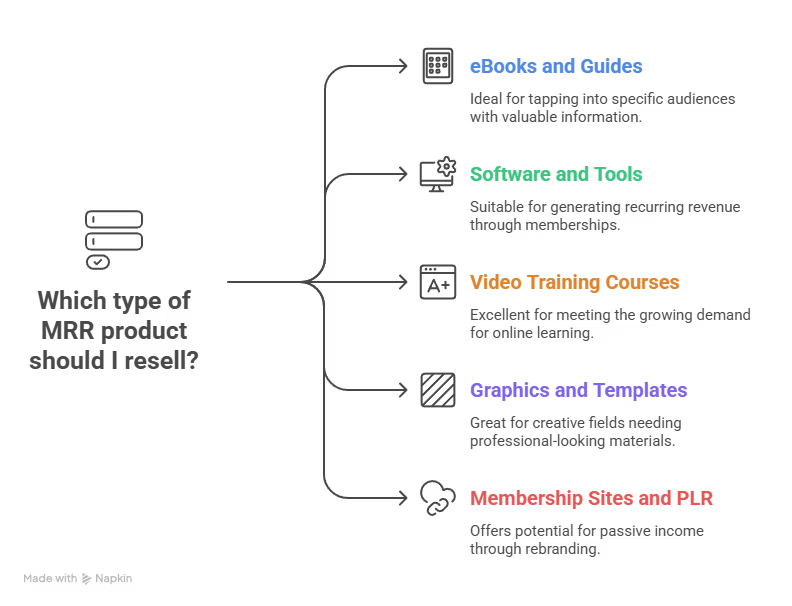
1. eBooks and Guides
One of the most popular types of mrr digital products are eBooks and informational guides. These are typically knowledge-based products that can cover a variety of topics, from self-help, marketing, personal finance, health, and fitness to more niche areas like productivity and digital entrepreneurship. Digital products for resale in the eBook category are perfect for entrepreneurs looking to tap into a specific audience with valuable information.
2. Software and Tools
Another category of MRR products is software and digital tools. These products are highly sought after due to their utility and value. They can include apps, plugins, or full-fledged software programs. Many marketers use these tools as part of a broader strategy to generate recurring revenue through memberships or software-as-a-service models.
3. Video Training Courses
If you’re looking for digital products to resell, video courses are also a great option. These can cover topics ranging from fitness coaching to social media marketing, and everything in between. As more people turn to online learning, the demand for high-quality educational content continues to grow, making video training courses an excellent choice for resale.
4. Graphics and Templates
For those in creative fields or the design industry, graphics and templates are highly marketable. These products can range from website themes, logo templates, to infographics, social media templates, and printables. Reselling design assets is a great way to tap into the growing demand for online business owners needing professional-looking materials without hiring a designer.
5. Membership Sites and Private Label Rights (PLR)
Lastly, you can resell membership sites and PLR content. This is a more advanced form of MRR products, but it has huge potential for passive income. A PLR product allows the buyer to rebrand and resell the content as their own. Some MRR products also come with membership rights, where you can grant others access to exclusive content or communities.
Is MRR legal? Are there risks involved?
Yes — MRR itself is a legitimate licensing model — but license clarity is what is important.
The terms of the license define what you can and cannot do: can you edit the product? can you distribute PLR as well? can you package it as well? Also watch out for misstated “exclusive” claims: many MRR products are distributed to many resellers (so there could be heavy competition). If you’re not sure about terms, treat the license like a contract — and consult a lawyer on large purchases.
Advantages of Selling MRR Digital Products
Selling MRR (Master Resell Rights) digital products offers numerous advantages that make it an attractive business model for entrepreneurs. Here are some key benefits:
1. Low Startup Costs
One of the most significant advantages of selling MRR products is the low initial investment. Unlike physical products, there’s no need for inventory, production, or shipping costs. You simply purchase the digital product with resale rights and can start selling immediately. This makes MRR products an affordable business opportunity for anyone with a limited budget.
2. Passive Income Potential
Once you’ve set up your sales funnel and marketing systems, selling MRR digital products can generate passive income. Digital products are scalable—after the initial setup, you can sell unlimited copies without incurring additional costs. This allows you to earn money while you focus on other aspects of your business or life.
3. No Product Creation Required
Creating a high-quality digital product can be time-consuming and requires expertise. With MRR products, you can skip this step altogether. You don’t need to worry about writing an eBook, designing a course, or developing software. Instead, you can focus on marketing and selling, leveraging the work of others while still reaping the rewards.
4. Instant Delivery and Global Reach
Since MRR digital products are delivered electronically, you can sell and distribute them instantly, no matter where your customers are located. This means you can operate on a global scale without the logistics challenges of physical product delivery. Your customers can access and download the product immediately after purchase, which enhances their buying experience and boosts sales.
5. High-Profit Margins
Because you’re selling digital products and there are minimal overhead costs, the profit margins can be substantial. After purchasing the product with resell rights, you keep 100% of the profits. There’s no need to share earnings with third-party suppliers or deal with manufacturing costs, allowing you to retain a significant portion of the revenue.
By taking advantage of these benefits, selling MRR products offers a flexible, scalable, and low-risk way to start a digital business.
Where to Buy MRR Products
Once you’ve decided which type of MRR product you’d like to sell, the next step is knowing where to buy MRR products. There are several marketplaces and platforms where you can purchase digital products with master resale rights, including:
- EasyElementor: Best site to get unlimited PLR & MRR products which includes variations in every niche.
- BuyQualityPLR.com: A trusted platform offering various categories of MRR products like eBooks, videos, and software.
- DesignedForYouToSell.com: A marketplace focused on MRR products that are ready to be marketed and sold.
- DigitalPLRHub.com: Another popular platform offering a range of trusted sources for MRR products, especially for entrepreneurs who want to sell digital marketing tools and content.
When purchasing MRR products, it’s crucial to ensure that the vendor offers high-quality products that align with your niche and audience. Verify the terms of the MRR license to make sure you’re compliant with the product’s resale conditions.
The Digital Product Creation Process
Creating successful digital products requires a systematic approach. While the allure of passive income is strong, achieving it consistently demands more than just a good idea—it requires a disciplined, step-by-step framework to efficiently transform a spark of inspiration into a polished, market-ready asset. Following a structured process not only increases your chances of commercial success but also saves you from wasted effort and costly pivots down the line.
Here is a proven, step-by-step framework to guide you from a blank page to a successful product launch:
Step 1: Ideation and Market Validation
This initial stage is about filtering your ideas through the lens of market demand. The goal is to find the sweet spot where your skills and passion intersect with a real problem people are willing to pay to solve.
- Technique: The “Jobs to Be Done” Framework: Instead of just thinking of a product, ask yourself, “What ‘job’ is my customer hiring a product to do?” Someone might “hire” a planner template to feel more organized, or “hire” a fitness ebook to gain confidence.
- Actionable Research:
- Listen on Social Media: Scroll through niche-specific communities on Facebook, Instagram, and LinkedIn. What questions are people repeatedly asking? What frustrations do they voice?
- Use SEO Tools: Google Trends and Google Keyword Planner are your best friends. They show you what people are actively searching for, revealing proven demand.
- Analyze Competitors: Look at best-selling products on Etsy or Udemy. Don’t copy them, but identify gaps. What did customers wish was included? What negative reviews did they leave?
- The Validation Check: Before you build anything, try to pre-sell or gather email sign-ups for the concept. If you can’t get a handful of people interested in the idea, you’ll struggle to sell the final product.
Here’s a tip I always give beginners: Your next product idea is already hidden in your DMs or comments. What do people consistently ask you for help with? That is your most validated product concept.
Step 2: Strategic Planning and Scope Definition
Once you have a validated idea, resist the urge to immediately start creating. Planning prevents “scope creep”—where a simple ebook suddenly becomes a 50-video course, causing you to burn out before launch.
- Define the Core Outcome: In one sentence, what will your customer be able to do or achieve after using your product? Every element you create should serve this core outcome.
- Create a Detailed Outline: For an ebook or course, this is your table of contents. For a template pack, this is a list of every file and its component parts. This outline is your blueprint and keeps you on track.
- Choose Your Tools: Decide on your tech stack upfront. Will you write in Google Docs? Design in Canva or Adobe? Record videos with Loom? Having this decided streamlines the entire process.
Step 3: The Development and Creation Phase
This is the “doing” phase where your product comes to life. The key here is consistency and batch-working to maintain quality and efficiency.
- Batch Your Tasks: Don’t jump between writing, designing, and recording. Instead, block out time for each type of work. For example:
- Week 1: Write all the core content.
- Week 2: Create all the graphics and worksheets.
- Week 3: Record and edit all videos.
- Focus on User-Centered Design: As you build, constantly put yourself in your customer’s shoes. Is the navigation intuitive? Are the instructions clear? Is the design visually appealing and easy to use? A great product is not just informative; it’s a pleasure to use.
Step 4: Quality Assurance and Beta Testing
Never be the only person to see your product before it goes live. A fresh set of eyes will catch errors and usability issues you’ve become blind to.
- Assemble a Beta Group: Recruit a small group (5-10 people) from your target audience. They can be from your email list, social media followers, or a paid group.
- Provide Specific Guidance: Don’t just ask, “What do you think?” Ask targeted questions:
- “Was there any step in the process that confused you?”
- “Did you encounter any technical glitches (broken links, etc.)?”
- “What was the most valuable part? What was the least?”
- Incorporate Feedback: Use this feedback to fix errors, clarify confusing sections, and even add new, requested elements. This phase transforms your good product into a great one.
Step 5: Launch Preparation and Pricing
With a polished product in hand, it’s time to prepare for the market. Your pricing and presentation are critical.
- Determine Your Pricing Strategy: Your price should reflect the value provided, your target audience’s budget, and competitor pricing. Don’t just race to the bottom; a higher price often signals higher quality.
- Build Your Sales Assets: Create a compelling sales page (on Shopify, Teachable, or your chosen platform), along with sales graphics, email sequences, and any promotional videos.
- The Final Checklist: Ensure all files are in the correct format, all links work, and your automated delivery system is flawlessly tested.
*Table: The 5-Phase Digital Product Creation Framework*
| Phase | Core Objective | Key Output |
|---|---|---|
| 1. Ideation & Validation | Find a problem worth solving | A validated product concept with a defined target audience |
| 2. Strategic Planning | Create a clear roadmap to avoid scope creep | A detailed outline, project timeline, and tool list |
| 3. Development | Transform the plan into a high-quality asset | The finished product (videos, text, design files) |
| 4. Quality Assurance | Refine the product based on real user feedback | A polished, error-free product ready for market |
| 5. Launch Prep | Set the stage for a successful commercial release | Pricing strategy, sales page, and marketing materials |
By following this structured process, you replace guesswork with a reliable framework. This disciplined approach significantly increases your likelihood of creating a digital product that not only exists but truly resonates with your audience and builds a sustainable source of income.
How to Market and Sell MRR Products
After purchasing your MRR products, it’s time to sell MRR products. Successful marketing involves more than just putting a product online and hoping for the best. You need to implement a strategy that ensures visibility and drives traffic to your sales page. Here’s how to market and sell your MRR products:
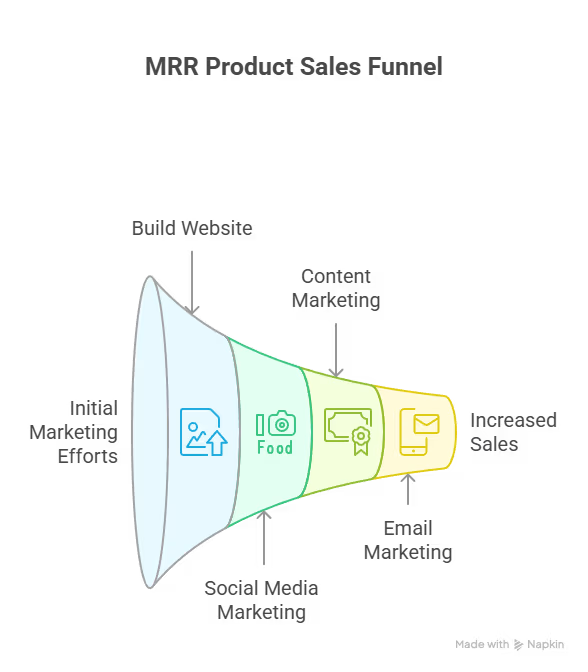
1. Build a Website or Sales Funnel
A professional website or landing page is essential for converting visitors into customers. Whether you use platforms like WordPress, Shopify, or ClickFunnels, make sure your website is optimized for conversions. A clear call-to-action, attractive product images, and persuasive copywriting can all help convert leads into buyers.
2. Utilize Social Media Marketing
Social media platforms like Facebook, Instagram, and YouTube are powerful tools for driving traffic and building an audience. You can use organic marketing strategies by posting valuable content and engaging with your followers, or you can use paid ads to reach a wider audience. Ads on platforms like Facebook and Google are great for targeted marketing to reach people interested in MRR products.
3. Content Marketing
Create high-quality, informative content that drives traffic to your website. Use blog posts, tutorials, and videos to educate your audience about the value of the MRR products you’re selling. This will help you establish authority in your niche and build trust with potential customers.
4. Leverage Email Marketing
Building an email list is one of the most effective ways to sell MRR products. Offer a free resource (like a lead magnet or eBook) in exchange for a visitor’s email address. Once you have a list, you can send follow-up emails that promote your MRR products or offer special discounts to incentivize purchases.
Legal Considerations with MRR Products
When selling MRR products, it’s essential to understand the legal aspects of mrr products. Each product comes with its own set of rules regarding resale, including:
- Resell Rights Terms: Ensure that you understand the master resale rights laws that govern the resale of digital products. Some products come with restrictions on how and where they can be sold, and violating these terms can result in losing access to the product or facing legal consequences.
- Rebranding and Modifications: Some MRR products allow you to modify or rebrand them, while others do not. Always check the terms before making changes to the product.
By understanding the legalities of selling MRR products, you can avoid issues down the road and ensure your business remains compliant.
How to Scale Your MRR Product Business
Once you’ve mastered the basics of reselling MRR products, it’s time to look at how you can scale your MRR business. Growth is possible by focusing on a few key strategies:
1. Automate Your Marketing and Sales
Use automation tools to handle email marketing, social media posts, and sales. Automation can save you time and help maintain consistent communication with your customers.
2. Expand Your Product Line
To grow your business, consider diversifying the types of mrr products you offer. By selling more products, you’ll have the opportunity to cross-sell and upsell to your existing customer base.
3. Focus on Customer Retention
Retaining existing customers is much cheaper than acquiring new ones. Offer excellent customer service, provide ongoing value through additional content, and create a loyalty program to keep customers coming back.
Typical MRR digital product types
- Ebooks and reports
- Video courses and webinars
- Slide decks and templates (PowerPoint, Canva)
- Software or applications (with distribution rights)
- Graphics, mockups, planners, and printables
These are bundled with sales pages, graphics, product files and the license file — check what’s included before purchasing.
Why MRR can work — and why many sellers fail
- Why it succeeds: minimal production cost (you don’t create content), immediate stock of product, and resellability.
- Why most fail: market saturation (identical product sold by many people), incorrect positioning, horrible sales copy, or abandonment of foundational marketing like email lists and funnels. MRR helps with supply of products — you still have to sell intelligently.
How-to: step-by-step guide to selling and making money using MRR digital products
Use this playbook — every step is actionable.
Step 1 — Choose a profitable niche & product
- Choose a niche you are familiar with (e.g., productivity, creator graphic templates, newbie coding).
- Browse marketplaces for top-quality MRR products in that niche — look at sample chapters, video quality, and assets made available (sales page, graphics, license).
Step 2 — Read the license (don’t skip)
- Confirm if you are allowed to resell, rebrand, or transfer resale rights.
- Verify refund/transfer terms and geo or platform restrictions.
- Clarify an ambiguous license in writing from the vendor if necessary.
Step 3 — Add value (the 80/20 that wins)
- Creating the same file as a dozen others to sell is a race to the bottom. Instead:
- Bundle MRR product with bonuses (checklists, mini companion video, templates).
- Create a short, differentiated introduction or rearrange cover/graphics if allowed by license.
- Develop a one-page branded sales page and a PDF “quick start” guide.
- Value-adds enable you to price higher and reduce direct competition.
Step 4 — Choose where to sell
- Options appropriate for MRR:
- Gumroad or Sellfy — rapid setup for digital downloads.
- Etsy — best for templates, printables, planners.
- Your site with Easy Digital Downloads, WooCommerce, or ThriveCart for checkout funnels and affiliates.
- Marketplaces and PLR communities (for bulk consumers).
- Each channel has pros/cons (fees, visibility, branding). Use one base channel first, then expand.
Step 5 — Price smartly
- Common tactics:
- Welcome ebook: $7–$27.
- Mini-course or multi-file bundle: $27–$97.
- Higher-priced courses or software: $97–$497+.
- You can also leverage tiered offers: a low-cost $7-$17 entry product, then upsell a $47 bundle with bonuses. Test prices and watch conversion rates.
Better Marketing
Example (simple math): 100 customers × $17 = $1,700 in revenue. If you have a fee-adjusted net margin of ~80%, that’s ~$1,360 in profit. That’s hard, repeatable cash if you can convert traffic consistently. (This is a fictional example — your mileage will vary.)
Step 6 — Build a simple funnel
- Free opt-in (a single-page checklist borrowed from the MRR product) → get email.
- Welcome sequence (3–5 emails) building trust and selling the low-ticket MRR offer.
- Launch email + scarcity (time-limited bonus or discount).
- Post-purchase upsell (bundle the MRR product with consulting, templates, or an advanced-level course).
- Email-first funnels convert way better than cold social posts.
Step 7 — Traffic: organic + paid + affiliates
- Organic: blog posts, SEO (target “how to” + niche keywords), YouTube short demos, Pinterest for templates.
- Paid: Facebook/Instagram ads, Google search intent buyers. Optimize and begin small.
- Affiliates: give affiliates a 30–50% commission to tap into someone else’s audience. Affiliates work with instant products.
Step 8 — Post-sale support & scaling
- Offer instant downloads and a short support email sequence.
- Obtain testimonials and reviews to increase conversions.
- Scale through building bundles, memberships, or monthly “product clubs” where members get new MRR assets each month (turns single sales into recurring revenue).
- Speed checklist before you buy an MRR product
- License file readily available and clean
- Copy on sales page included or easily editable
- High-quality product files (video/audio/pdf)
- Resale permission to bundle or pass through resale rights (if that is what you plan to do)
- No sneakily included vendor franchises or “pay-to-earn” rubbish
Common mistakes & how to avoid them
While selling MRR products can be highly profitable, there are several common mistakes that many newcomers to this business make. Avoiding these errors can help you build a sustainable and successful MRR business.
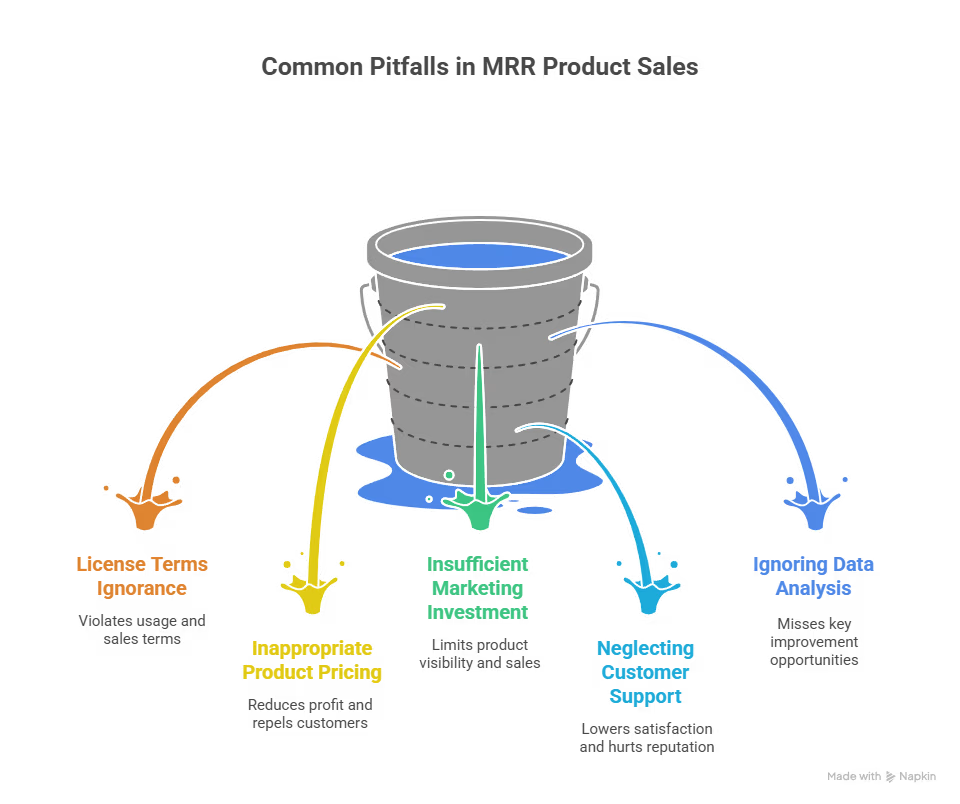
- 1. Failing to Understand the Product’s License Terms : One of the most critical mistakes people make is not fully understanding the license terms of the MRR products they’re selling. Each product typically has specific terms of use that you must adhere to. Some products may allow you to rebrand them, while others do not. Additionally, some licenses might restrict where or how you can sell the product. For example, certain MRR digital products may only be allowed to be sold through certain platforms, such as your website, a marketplace, or through a specific affiliate program.
- 2. Overpricing or Underpricing Products : Pricing your MRR products is an art. You want to make sure that you’re pricing them competitively while also ensuring you’re maximizing your profit margins. Overpricing can turn away potential customers, while underpricing may lead to missed revenue opportunities. To find the right price point, research the competition, consider the product’s perceived value, and test different pricing strategies. It’s important to sell mrr products at a price that reflects their value but still fits within your target audience’s budget.
- 3. Not Investing Enough in Marketing : One of the key mistakes new MRR product sellers make is thinking that the product will sell itself. Unfortunately, this isn’t the case. Selling MRR products requires effective digital marketing strategies. Whether you’re relying on social media marketing, SEO, or email marketing, consistently driving traffic to your sales pages is essential. Even if the product is great, you need to promote it properly to get sales.
- 4. Ignoring Customer Support : Providing excellent customer support is crucial for building a loyal customer base. Neglecting customer inquiries or failing to provide timely responses can lead to negative reviews, reduced customer satisfaction, and ultimately lower sales. Always ensure that you have a support system in place and that you’re responsive to your customers’ needs. This goes beyond just handling complaints—make sure to be proactive and offer additional value, like free updates or bonuses, where possible.
- 5. Not Tracking and Analyzing Data : In the digital marketing world, data is king. By tracking metrics like traffic, conversion rates, and customer behavior, you can continuously improve your sales strategies and marketing tactics. Without analyzing your sales performance and traffic sources, you may miss opportunities for improvement. Utilize tools like Google Analytics, email campaign trackers, and A/B testing to optimize your sales funnels and marketing campaigns.
Profitability and Feasibility of MRR Products
The allure of MRR products is their potential for high profits with low ongoing effort. However, like any business model, it’s important to assess whether selling MRR products is truly profitable for your specific situation. Here are some factors to consider when evaluating the profitability of MRR products:
1. Low Overhead Costs
One of the most significant advantages of selling MRR products is the low overhead. Unlike physical products that require manufacturing, storage, and shipping, digital products can be sold repeatedly without any additional costs per unit. Once you’ve purchased a product with master resale rights, you can sell it to as many customers as you want without incurring any additional costs.
2. Passive Income Potential
MRR products also offer passive income potential. After setting up your sales funnel, automating your marketing, and making your website live, you can continue making sales without needing to invest a lot of ongoing time. The key is to create an automated system where sales, follow-ups, and customer interactions are handled by tools and systems you’ve set up. This allows you to focus on growing your business further while your MRR products keep generating income.
3. Scalability
Another benefit of selling MRR products is that your business can scale relatively quickly. As you build your digital business and acquire more mrr products to sell, you can increase your revenue without a corresponding increase in costs. Adding more products, expanding into new niches, and improving your marketing strategies all allow you to scale without significantly adding more overhead or complexity.
4. Market Demand for Digital Products
The demand for digital products continues to rise year after year, as more people move online for solutions. Whether it’s for learning new skills, improving productivity, or using specialized software tools, digital products are in high demand. This trend makes MRR products a lucrative option, especially if you focus on evergreen niches like personal development, finance, or business growth.
How to Scale Your MRR Product Business
If you’ve mastered the basics of selling MRR products and want to take your business to the next level, scaling is the next logical step. Scaling a business involves expanding your reach, increasing profits, and automating your processes so you can grow without increasing your workload exponentially.
Here are some tips for scaling your MRR business:
1. Optimize Your Sales Funnel
Your sales funnel is the process that guides potential customers from the awareness stage to the purchase stage. To scale your MRR business, it’s essential to continually optimize this funnel to increase conversions. Start by testing different landing pages, calls to action (CTAs), and sales copy. Make sure that your funnel is easy to navigate, provides clear value, and includes strong incentives for customers to purchase your MRR products.
2. Diversify Your Product Line
While you may start with one or two MRR products, expanding your product line over time is crucial for long-term growth. Offering a variety of products allows you to cater to different segments of your audience and increases your chances of making a sale. Look for complementary products that align with your current offerings or explore new niches where you can provide value.
3. Invest in Paid Advertising
Once your organic marketing strategies start to yield results, it might be time to invest in paid ads. Platforms like Facebook, Instagram, and Google Ads allow you to target specific demographics and keywords to drive highly relevant traffic to your website. Paid ads can be a game-changer for scaling your business, especially when you’ve optimized your funnel and know what works.
4. Automate and Outsource Tasks
To scale effectively, you’ll need to automate and outsource various tasks. Tools like email automation platforms (e.g., Mailchimp, ConvertKit), social media scheduling tools (e.g., Buffer, Hootsuite), and eCommerce platforms (e.g., Shopify) can help streamline your processes. Additionally, as your business grows, consider outsourcing tasks like customer support, content creation, or marketing to free up your time for strategic decision-making.
5. Focus on Customer Retention
Building a loyal customer base is key to long-term growth. Repeat customers are often more valuable than new customers, so focusing on customer retention should be a priority. Offer bonuses, loyalty programs, or exclusive deals to keep your customers coming back. Building relationships through email newsletters and providing consistent value can help foster a sense of loyalty and trust.
Final words — is MRR right for you?
In conclusion, selling MRR products offers a fantastic opportunity for entrepreneurs looking to start an online business with minimal upfront investment and low ongoing costs. By understanding the types of MRR products, avoiding common mistakes, and implementing the right marketing and sales strategies, you can build a sustainable and profitable business. With the potential for passive income, scalability, and the ability to tap into high-demand digital products, there’s a lot to gain from reselling MRR products.
However, like any business, success with MRR products requires effort, strategy, and continuous optimization. If you are committed to learning, growing, and adapting to changing trends, the opportunities in the MRR market are vast. So, if you’re wondering whether MRR products profitability is right for you, take the leap, do the research, and put in the work—success could be just around the corner.

